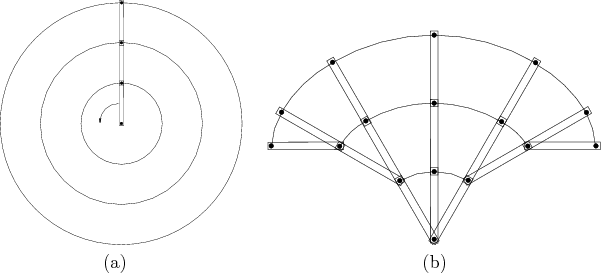
Next: Computing bounds on joint Up: 7.4.2 Active-Passive Link Decompositions Previous: Active and passive variables
The random loop generator greatly improves the chance of
obtaining closure by iteratively restricting the range on each of the
active variables. The method requires that the active variables
appear sequentially along the chain (i.e., there is no interleaving of
active and passive variables). The ![]() coordinates of
coordinates of ![]() are
obtained sequentially as follows. First, compute an interval,
are
obtained sequentially as follows. First, compute an interval, ![]() ,
of allowable values for
,
of allowable values for ![]() . The interval serves as a loose bound
in the sense that, for any value
. The interval serves as a loose bound
in the sense that, for any value
![]() , it is known for
certain that closure cannot be obtained. This is ensured by
performing a careful geometric analysis of the linkage, which will be
explained shortly. The next step is to generate a sample in
, it is known for
certain that closure cannot be obtained. This is ensured by
performing a careful geometric analysis of the linkage, which will be
explained shortly. The next step is to generate a sample in
![]() , which is accomplished in [244] by picking a random
point in
, which is accomplished in [244] by picking a random
point in ![]() . Using the value
. Using the value ![]() , a bounding interval
, a bounding interval ![]() is
computed for allowable values of
is
computed for allowable values of ![]() . The value
. The value ![]() is
obtained by sampling in
is
obtained by sampling in ![]() . This process continues iteratively
until
. This process continues iteratively
until ![]() and
and ![]() are obtained, unless it terminates early
because some
are obtained, unless it terminates early
because some
![]() for
for ![]() . If successful termination
occurs, then the active variables
. If successful termination
occurs, then the active variables ![]() are used to find values
are used to find values ![]() for the passive variables. This step still might fail, but the
probability of success is now much higher. The method can also be
applied to linkages in which there are multiple, common loops, as in
the Stewart-Gough platform, by breaking the linkage into a tree and
closing loops one at a time using the loop generator. The performance
depends on how the linkage is decomposed [244].
for the passive variables. This step still might fail, but the
probability of success is now much higher. The method can also be
applied to linkages in which there are multiple, common loops, as in
the Stewart-Gough platform, by breaking the linkage into a tree and
closing loops one at a time using the loop generator. The performance
depends on how the linkage is decomposed [244].
 |
Steven M LaValle 2012-04-20